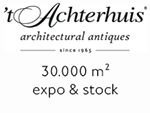|
Antheit (Belgium) 1897 - Veurne (Belgium) 1994
The paining has been part of the same private collection for two generations.
Original frame, painted on canvas and in excellent condition.
On the backside is an exhibition label from the exhibition in the Royal Museum of Fine Art of Belgium in Brussels in 1997. The painting was also published in the catalogue of the exhibition.
Biography
Delvaux was born in Antheit in the Belgian province of Liège, the son of a lawyer. The young Delvaux took music lessons, studied Greek and Latin, and absorbed the fiction of Jules Verne and the poetry of Homer. All of his work was to be influenced by these readings, starting with his earliest drawings showing mythological scenes. He studied at the Académie Royale des Beaux-Arts in Brussels, albeit in the architecture department owing to his parents' disapproval of his ambition to be a painter. Nevertheless, he pursued his goal, attending painting classes taught by Constant Montald and Jean Delville. The painters Frans Courtens and Alfred Bastien also encouraged Delvaux, whose works from this period were primarily naturalistic landscapes. He completed some 80 paintings between 1920 and 1925, which was the year of his first solo exhibition.
Delvaux's paintings of the late 1920s and early 1930s, which feature nudes in landscapes, are strongly influenced by such Flemish Expressionists as Constant Permeke and Gustave De Smet. A change of style around 1933 reflects the influence of the metaphysical art of Giorgio de Chirico, which he had first encountered in 1926 or 1927. In the early 1930s Delvaux found further inspiration in visits to the Brussels Fair, where the Spitzner Museum, a museum of medical curiosities, maintained a booth in which skeletons and a mechanical Venus figure were displayed in a window with red velvet curtains. This spectacle captivated Delvaux, supplying him with motifs that would appear throughout his subsequent work. In the mid-1930s he also began to adopt some of the motifs of his fellow Belgian René Magritte, as well as that painter's deadpan style in rendering the most unexpected juxtapositions of otherwise ordinary objects.
Delvaux acknowledged his influences, saying of de Chirico, "with him I realized what was possible, the climate that had to be developed, the climate of silent streets with shadows of people who can't be seen, I've never asked myself if it's surrealist or not." Although Delvaux associated for a period with the Belgian surrealist group, he did not consider himself "a Surrealist in the scholastic sense of the word." As Marc Rombaut has written of the artist: "Delvaux ... always maintained an intimate and privileged relationship to his childhood, which is the underlying motivation for his work and always manages to surface there. This 'childhood,' existing within him, led him to the poetic dimension in art."
The paintings Delvaux became famous for usually feature numbers of nude women who stare as if hypnotized, gesturing mysteriously, sometimes reclining incongruously in a train station or wandering through classical buildings. Sometimes they are accompanied by skeletons, men in bowler hats, or puzzled scientists drawn from the stories of Jules Verne.[7] Delvaux would repeat variations on these themes for the rest of his long life, although some departures can be noted. Among them are his paintings of 1945-47, rendered in a flattened style with distorted and forced perspective effects, and the series of crucifixions and deposition scenes enacted by skeletons, painted in the 1950s.
In the late 1950s he produced a number of night scenes in which trains are observed by a little girl seen from behind. These compositions contain nothing overtly surrealistic, yet the clarity of moonlit detail is hallucinatory in effect. Trains had always been a subject of special interest to Delvaux, who never forgot the wonder he felt as a small child at the sight of the first electric trams in Brussels.
In 1959 he executed a mural at the Palais des Congrès in Brussels, one of several large scale decorative commissions Delvaux undertook. He was named director of the Académie royale des Beaux-arts in 1965. In 1982 the Paul Delvaux Museum opened in Saint-Idesbald. Delvaux died in Veurne in 1994.
|




























